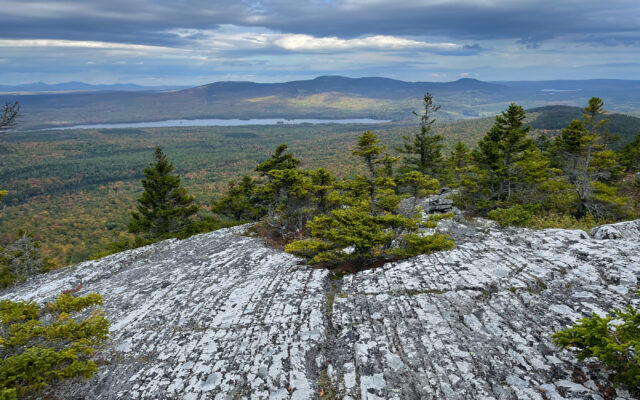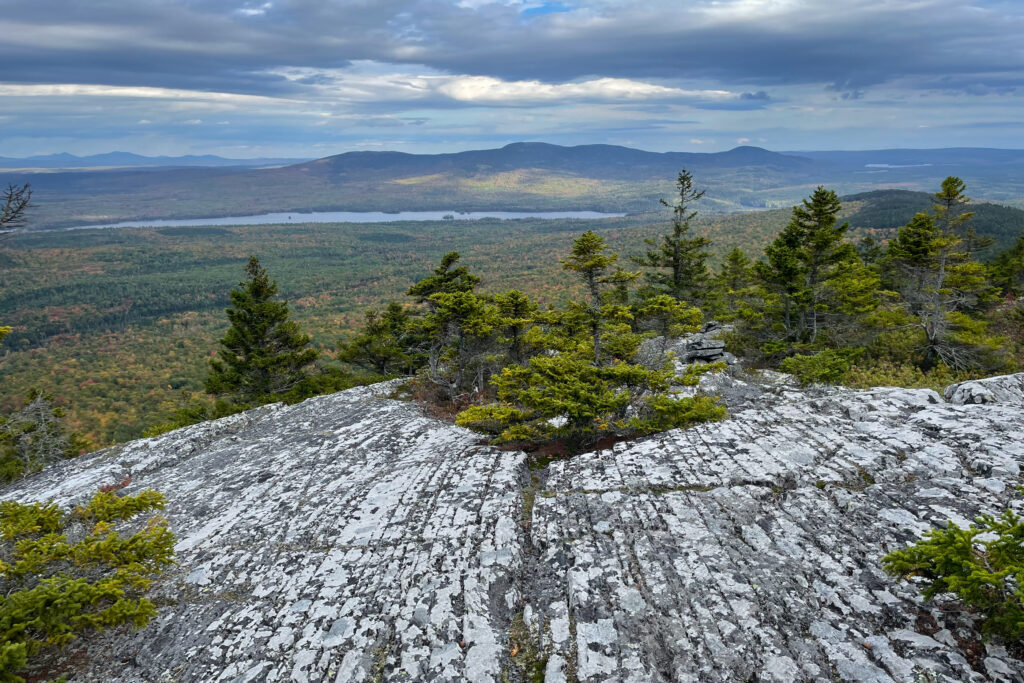
Get a taste of the Maine Appalachian Trail with an incredible hike on Pleasant Pond Mountain
By Aislinn Sarnacki
Fat, red maple leaves littered the trail, a crimson carpet threaded with tree roots. Stepping carefully so as not to trip, I followed the vibrant path. White painted rectangles marked tree trunks along the way, reminding me that I was walking a section of the famous Appalachian Trail.
A continuous footpath spanning from Georgia to Maine, the National Scenic Appalachian Trail measures roughly 2,190 miles long and is a unit of the National Park System. Each year, hundreds of long-distance hikers attempt to walk it from end to end, sleeping at campsites and hostels along the way.
Since I’m an avid hiker, several people have asked me: “Would you like to hike the entire AT someday?” And I have to be honest with them. No, I don’t think I’ll ever want to hike and tent out for five to seven months straight. I think it’s a wonderful achievement. It’s just not for me.

PLEASANT POND MOUNTAIN — A patch of sunlight illuminates part of the landscape seen from an overlook on Pleasant Pond Mountain on Sept. 27.
But that doesn’t mean I can’t enjoy the AT and its many natural wonders. The trail is an excellent place for short adventures, such as day hikes or weekend camping trips.
My most recent hike on the AT was up Pleasant Pond Mountain near the small town of Caratunk in western Maine. At the end of September it wasn’t quite peak fall foliage in the area, but many of the maple and aspen leaves had turned fiery colors.
A peaceful silence had settled over the forest that afternoon. Gray clouds scuttled overhead, threatening rain. Bright yellow-orange Amanita mushrooms, some as large as dinner plates, sprouted beside the trail and all through the surrounding woods. I could imagine fae folk flitting about, casting spells on unsuspecting hikers.
The entire AT is marked in white paint. In my travels, I’ve noticed that other trails in Maine are often marked in blue or orange paint. And some organizations, such as land trusts, mark their trails with custom-made markers such as tiny metal signs of various colors. But finding a non-AT trail marked in white is rare.

SNIFFING AROUND — Juno inspects a cluster of large mushrooms beside the Appalachian Trail.
There’s a special feel to the AT. Maybe that’s just because I know how many people have walked the path with such purpose and determination. Every time I follow its white blazes, the specialness of the pathway is a concept that’s ever present in the back of my mind.
The only downside to the AT’s white blazes is that they can easily blend into the snow.
Rising 2,447 feet above sea level, Pleasant Pond Mountain is just one of the many mountains along the AT, which follows the Appalachian Mountain Range through 14 states. Other mountains in Maine that I’ve hiked by following the AT include Old Speck, Chairback, Barren, Third, Moxie Bald and Katahdin. I’ve also hopped onto the AT for lowland hikes to landmarks such as Little and Big Niagara Falls in Baxter State Park. And I once enjoyed an overnight trip on the AT to hike the Bigelow Mountain Range, staying in a tent at a campsite near one of the range’s peaks.
Maine is home to the northernmost 281 miles of the AT, which ends atop the state’s tallest mountain, Katahdin. Most thru-hikers (those who set out to hike the entire trail) choose to hike from south to north, which means they hit Maine last. And that’s probably a good thing. Maine’s section of the trail is known to be the most arduous and remote — in addition to the White Mountains of New Hampshire.
The Maine Appalachian Trail Club maintains the vast majority (267 miles) of the trail in Maine, with volunteer stewards taking responsibility for different sections. I joined longtime MATC volunteer Ron Dobra on the trail back in 2015 to write a story about the need for MATC volunteers. I followed him around while he lopped off overhanging tree limbs and replaced weathered signs. I’m afraid I wasn’t much help.
In the fall of 2016, I tagged along with an MATC crew as they constructed a new privy at the campsite located at the base of Pleasant Pond Mountain. As it turns out, providing hikers with nice outhouses to use is an important way to protect the resource — and keep hikers happy.
It was back then that I first hiked Pleasant Pond Mountain. When I reached the top, the open view was so breathtakingly beautiful that it actually brought tears to my eyes (which is rare for me). Fall foliage was at its peak. Cloaked in orange, the surrounding fills appeared as if on fire.
Returning to the mountain this fall with my dog, Juno, I knew what wonder awaited us at the top — if the shifting rain clouds didn’t obscure the view. About halfway up the mountain, as we navigated a particularly root-filled section of trail, the sun broke through the clouds and canopy. Encouraged by its appearance, I hurried onward and upward.
We made it to the top just before the rain rolled in. At the best overlook, which is just beyond the summit (heading north on the AT), I watched the dark clouds draw closer, casting the land below in a moody shadow.
Somewhere near the summit, Juno found an old, dried up stick that she insisted on carrying down the mountain. We made it about a third of the way down before she dropped and forgot about it on a bed of moss.
It was her first hike on the AT, and I’m sure there will be many more. There are still plenty of day hikes and overnight trips on the trail in Maine that I’ve yet to experience. Then, of course, there’s the rest of the trail, through 13 other states. I hear the stretch in Vermont is especially lovely. When you’re a hiker, the options really are endless.